Body Mass Index and Response to Antidepressants in Depressed Research Subjects
To the Editor: Recent investigations indicate that obese individuals are more prone to depression than nonobese individuals and depressed patients are more overweight than nondepressed people.1,2 This might be because chronic physical (eg, obesity) and psychological (eg, depression) stress sets off systemic inflammatory reactions in the body.3 Such low-grade, generalized inflammation could contribute to, among other things, chronic or aging diseases, including coronary artery disease, diabetes, cancer, and Alzheimer’s disease.4 Independent of aging, inflammatory markers (such as C-reactive protein) have been linked with mood disorders, especially major depressive disorder (MDD). Lydiard5 has suggested that antidepressant effects of antidepressants are mainly due to their stress-buffering properties. Finally, Rosmond6 proposes the idea that obesity and depression might represent different manifestations of the same disease process; dysregulation of certain common pathways or neurotransmitters can increase an individual’s vulnerability to both depression and obesity.
Previously, it was found that greater relative body weight predicted nonresponse to antidepressant medication.7 Here, we present additional evidence indicating that obesity, as an important component of the cycle of stress, might be associated with more treatment-resistant depression. We tested our hypothesis that clinically depressed obese patients, when compared with depressed patients with a healthy weight, will be less likely to respond to currently marketed antidepressant medications.
Method. A meta-analysis of 3 completed clinical trials, all double-blind, flexible-dose, active-controlled comparisons of antidepressants in the treatment of MDD (conducted at Pharmacology Research Institute [PRI] clinics in southern California), was performed. Each study lasted a total of 8 weeks. The studies were initiated and completed between 2003 and 2006 and included comparison of selective serotonin reuptake inhibitors (SSRIs) and serotonin-norepinephrine reuptake inhibitors (SNRIs). A total number of 59 outpatients, adults ages 18 to 65 years, with a diagnosis of MDD were the subjects of the trials. The subjects met the inclusion and exclusion criteria of the trials, which were very similar in all 3 studies. The MDD diagnosis was based on the DSM-IV-TR criteria, confirmed by the Mini-International Neuropsychiatric Interview.8
Measures used to monitor depression were the Hamilton Depression Rating Scale (HDRS),9 the Montgomery-Asberg Depression Rating Scale (MADRS),10 and the Clinical Global Impressions scale (CGI).11 Patients were randomly assigned to one of several marketed antidepressant medications (a total of 4 SSRIs and 2 SNRIs). There were no placebo arms in these studies.
Results. The baseline scores for the body mass index (BMI) groups were not significantly different from each other on any of the measures. The mean baseline HDRS scores were 22.0, 22.2, and 22.3 for the normal BMI (20.0-24.9, n = 19), overweight (BMI, 25.0-29.9; n = 19), and obese (BMI, 30.0-39.9; n = 21) groups, respectively. For the MADRS, the mean baseline scores were 31.3, 31.5, and 29.6, respectively. The total rate of dropouts was 16%, which was relatively uniform for all 3 BMI groups.
Patients with a normal BMI had a greater response to the marketed antidepressants when compared with overweight and obese patients. The differences were statistically significant at P < .005 for all 3 measures (HDRS, MADRS, and CGI). The end-of-treatment mean HDRS score for the normal BMI group was 7.7, followed by 11.6 and 12.7 for the overweight and obese groups, respectively. For the MADRS, the end-of-treatment mean scores for the 3 groups were 10.9, 15.4, and 17.9 in the normal BMI, overweight, and obese groups, respectively. The results of the overweight and obese groups were not significantly different from each other on any of the stated measures. However, both overweight and obese patients improved with antidepressant treatments, the overweight group more than the obese group.
Since there were no placebo arms in these studies, antidepressant treatments could not be directly compared with a placebo group. Nonetheless, for each of these antidepressant compounds, at least 2 positive, pivotal, double-blind, placebo-controlled trials served as the basis of their US Food and Drug Administration-approved (for commercial marketing) status. Consequently, the antidepressant medications in these studies were previously demonstrated to be significantly more efficacious than placebo in the treatment of MDD.
Our studies were flexible-dose comparisons of antidepressants. As a result, antidepressants were titrated as deemed necessary for optimal response and tolerability. Consequently, overweight and obese patients were not committed to fixed doses of antidepressants; their doses could be titrated up if they were not improving at lower doses.
Research suggests a relationship between obesity, stress, inflammation, and depression; they seem to interact with one another in a positive feedback loop. It is reasonable to expect that eliminating one of the constituents of the cycle could ease or interrupt the cascade of such reactions. This analysis shows the possible effect of obesity on the intractability of depression to antidepressant treatment.
Earlier results have shown that obesity elevates the level of inflammatory markers in the body. This, in turn, can contribute to the resistance of MDD to treatment with some of the currently marketed antidepressants. Obesity, as an added stressor, separate from inflammatory factors, can also interfere with the brain’s response to treatment. Finally, obese patients might have a different kind of depression that requires antidepressants with novel mechanisms of action.
Our report reflects statistically and clinically significant results indicating that increased body weight is associated with a decreased response rate to antidepressants. In view of the small number of subjects in this meta-analysis, the results should be considered preliminary. Larger and prospective studies that also include morbidly obese depressed patients could shed more persuasive light on the validity of the findings, especially if antidepressants can be compared directly to placebo for different categories of BMIs.
If our results can be further substantiated in the future, several interesting and practical questions can be raised, such as, "Why do obese depressed patients respond differently to treatment with antidepressants and how can this difference be incorporated into the differential management of depressed patients?"
The exact mechanisms that contribute to the findings of this meta-analysis, while still implied, are of significant potential value. Understanding these mechanisms is important due to the high prevalence of both MDD and obesity in the general public and the high costs of failed treatments for the individual and society at large. An interesting question to investigate is whether obese depressed patients are, in fact, more prone to placebo responsiveness. Another unaddressed question is whether weight loss in obese patients will make them more responsive to antidepressants.
References
1. Simon GE, VonKorff M, Saunders K, et al. Association between obesity and psychiatric disorders in the US adult population. Arch Gen Psychiatry 2006;63(7):824-830 PubMed doi:10.1001/archpsyc.63.7.824
2. Markowitz S, Friedman MA, Arent SM. Understanding the relation between obesity and depression: causal mechanisms and implications for treatment. Clin Psychol Sci Pract. 2008;15(1):1-20. doi:10.1111/j.1468-2850.2008.00106.x
3. Dantzer R, O’ Connor JC, Freund GG, et al. From inflammation to sickness and depression: when the immune system subjugates the brain. Nat Rev Neurosci. 2008;9(1):46-56. PubMed doi:10.1038/nrn2297
4. Omoigui S. The interleukin-6 inflammation pathway from cholesterol to aging—role of statins, bisphosphonates and plant polyphenols in aging and age-related diseases. Immun Ageing. 2007;4(1):1-22. PubMed doi:10.1186/1742-4933-4-1
5. Lydiard RB. Worried sick: antidepressants, stress, and inflammation. J Clin Psychiatry. 2007;68(10):1613-1614. PubMed
6. Rosmond R. Obesity and depression: same disease, different names? Med Hypotheses. 2004;62(6):976-979. PubMed doi:10.1016/j.mehy.2003.12.030
7. Papakostas GI, Petersen T, Iosifescu DV, et al. Obesity among outpatients with major depressive disorder. Int J Neuropharmacol. 2005;8(1):59-63.
8. Sheehan DV, Lecrubier Y, Harneh-Sheehan K, et al. The Mini-International Neuropsychiatric Interview (MINI): the development and validation of a structured diagnostic psychiatric interview for DSM-IV and ICD-10. J Clin Psychiatry. 1998;59(suppl 20):22-23. PubMed
9. Hamilton M. A rating scale for depression. J Neurol Neurosurg Psychiatry. 1960;23:56-62. PubMed doi:10.1136/jnnp.23.1.56
10. Montgomery SA, Asberg M. A new depression scale designed to be sensitive to change. Br J Psychiatry. 1979;134:382-389. PubMed doi:10.1192/bjp.134.4.382
11. Guy W. ECDEU Assessment Manual for Psychopharmacology. US Dept Health, Education, and Welfare publication (ADM) 76-338. Rockville, MD: National Institute of Mental Health; 1976:218-222.
Author affiliations: Pharmacology Research Institute, Newport Beach (Dr Oskooilar and Ms Tong); Pharmacology Research Institute, Los Alamitos (Dr Wilcox); and Pharmacology Research Institute, Encino (Dr Grosz), California. Financial disclosure: None reported. Funding/support: These data were generated as part of several large pharmaceutical, multicenter, double-blind clinical trials. The tabulation and statistical analyses of the results were funded (internally) by Pharmacology Research Institute. Previous presentation: The data of this investigation were presented in a scientific poster in the 48th Annual Meeting of NCDEU; May 27-30, 2008; Phoenix, Arizona.
doi:10.4088/JCP.09l05226blu
© Copyright 2009 Physicians Postgraduate Press, Inc.




